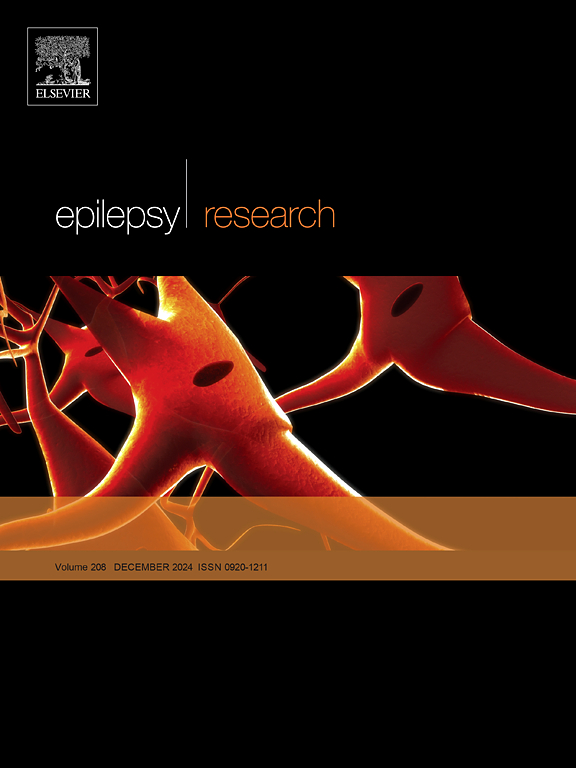The relationship between ghrelin, epilepsy-related inflammatory biomarkers (IL-1β, IL-1R1, HMGB1), and drug-resistant epilepsy in children
IF 2
4区 医学
Q3 CLINICAL NEUROLOGY
引用次数: 0
Abstract
Purpose
This study aimed to investigate the relationship between ghrelin levels and severity of inflammation in children with epilepsy by evaluating the differences in total ghrelin, High Mobility Group Box 1 (HMGB1), Interleukin-1 Receptor Type 1 (IL1R1), and Interleukin-1 Beta (IL1-β) levels in patients with drug-resistant and non-drug-resistant epilepsy and comparing these parameters with those of healthy controls.
Methods
We measured total ghrelin, HMGB1, IL1R1, and IL1-β levels—known to play roles in epileptogenesis—in patients with severe (n: 28), mild (n:29) epilepsy, and 31 healthy controls. The severe epilepsy group included patients with treatment-resistant epilepsy, while the mild epilepsy group consisted of patients whose seizures could be controlled with monotherapy.
Results
Total ghrelin levels, along with HMGB1, IL1R1, and IL1-β, were significantly elevated in children with epilepsy compared to healthy controls. This increase was more pronounced in the drug-resistant epilepsy group, suggesting a potential role for ghrelin in drug-resistant epilepsy. While no direct correlation was found between ghrelin and the inflammatory markers, we observed that ghrelin levels rose significantly when levels of IL1R1, IL1-β, and HMGB1 surpassed their respective cut-off values in epilepsy patients. The biomarkers IL1R1 and IL1-β had the strongest discriminative potential in distinguishing patients with severe epilepsy from healthy controls. Although ghrelin was not as powerful a diagnostic marker as IL1R1 or IL1-β, it still showed moderate diagnostic value.
Conclusion
Ghrelin could serve as a biomarker reflecting both inflammation and drug resistance in epilepsy. It may be associated with inflammatory responses in epilepsy and could play a potential role in the pathophysiology of the disease.
胃饥饿素、癫痫相关炎症生物标志物(IL-1β、IL-1R1、HMGB1)与儿童耐药癫痫的关系
目的通过评价耐药和非耐药癫痫患者总胃饥饿素、高迁移率组盒1 (HMGB1)、白细胞介素-1受体1型(IL1R1)和白细胞介素-1 β (IL1-β)水平的差异,并与健康对照比较,探讨胃饥饿素水平与癫痫患儿炎症严重程度的关系。方法我们在28例重度(n: 28)、29例轻度(n:29)癫痫患者和31例健康对照中测量了已知在癫痫发生中起作用的总胃饥饿素、HMGB1、IL1R1和IL1-β水平。重度癫痫组包括难治性癫痫患者,轻度癫痫组包括单药治疗可控制癫痫发作的患者。结果癫痫患儿总胃饥饿素水平、HMGB1、IL1R1和IL1-β水平均显著高于健康对照组。这种增加在耐药癫痫组中更为明显,表明胃饥饿素在耐药癫痫中可能起作用。虽然胃饥饿素与炎症标志物之间没有直接相关性,但我们观察到,当癫痫患者的IL1R1、IL1-β和HMGB1水平超过各自的临界值时,胃饥饿素水平显著升高。生物标志物IL1R1和IL1-β在区分严重癫痫患者和健康对照中具有最强的鉴别潜力。虽然ghrelin作为诊断标志物的作用不如IL1R1或IL1-β,但仍具有中等的诊断价值。结论hrelin可作为反映癫痫炎症和耐药的生物标志物。它可能与癫痫的炎症反应有关,并可能在该病的病理生理中发挥潜在作用。
本文章由计算机程序翻译,如有差异,请以英文原文为准。
求助全文
约1分钟内获得全文
求助全文
来源期刊

Epilepsy Research
医学-临床神经学
CiteScore
0.10
自引率
4.50%
发文量
143
审稿时长
62 days
期刊介绍:
Epilepsy Research provides for publication of high quality articles in both basic and clinical epilepsy research, with a special emphasis on translational research that ultimately relates to epilepsy as a human condition. The journal is intended to provide a forum for reporting the best and most rigorous epilepsy research from all disciplines ranging from biophysics and molecular biology to epidemiological and psychosocial research. As such the journal will publish original papers relevant to epilepsy from any scientific discipline and also studies of a multidisciplinary nature. Clinical and experimental research papers adopting fresh conceptual approaches to the study of epilepsy and its treatment are encouraged. The overriding criteria for publication are novelty, significant clinical or experimental relevance, and interest to a multidisciplinary audience in the broad arena of epilepsy. Review articles focused on any topic of epilepsy research will also be considered, but only if they present an exceptionally clear synthesis of current knowledge and future directions of a research area, based on a critical assessment of the available data or on hypotheses that are likely to stimulate more critical thinking and further advances in an area of epilepsy research.
 求助内容:
求助内容: 应助结果提醒方式:
应助结果提醒方式:


